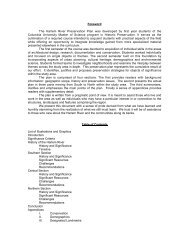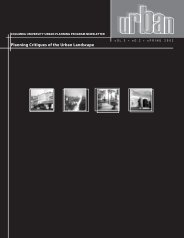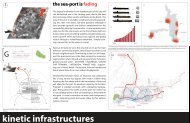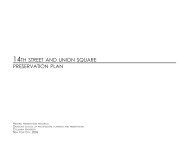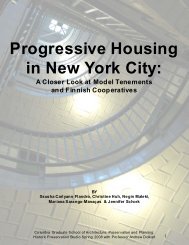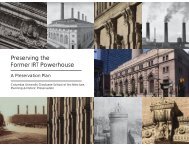The Art of Planning - Columbia University Graduate School of ...
The Art of Planning - Columbia University Graduate School of ...
The Art of Planning - Columbia University Graduate School of ...
Create successful ePaper yourself
Turn your PDF publications into a flip-book with our unique Google optimized e-Paper software.
16<br />
Bushwick, I wanted to present a collection <strong>of</strong><br />
non-traditional public spaces, with the hope<br />
<strong>of</strong> generating interplay <strong>of</strong> ideas between the<br />
differing spatial and emotional experiences.<br />
<strong>The</strong> spaces include a vacant lot left over<br />
from a razed building, an overgrown field<br />
surrounded by an unfinished warehouse<br />
foundation-wall, a stretch <strong>of</strong> freight train<br />
tracks crossing an industrial waterway, and a<br />
recently completed parking lot surrounding a<br />
large condominium. In addition to generating<br />
various architectural, archeological, and<br />
emotional experiences, I am also interested in<br />
making the sites more public through physical<br />
appropriation and by inviting others to explore<br />
spaces that might otherwise be considered<br />
<strong>of</strong>f-limits.<br />
Postscript: It is my hope that planners and<br />
artists will continue to dialogue about the<br />
issues that have been raised by this interview.<br />
Certainly, planners must be aware that culture<br />
has the potential to increase a neighborhood’s<br />
desirability, thereby fueling gentrification.<br />
But are the artists really to blame for the<br />
displacement? Shouldn’t there be space in<br />
the City for art-experimentation?<br />
Diede: Do you have any ideas on how cities (or urban planners) can/should respond<br />
to artists’ needs without limiting the creative possibilities that arise out <strong>of</strong> spontaneity<br />
and freedom <strong>of</strong>, um, space?<br />
Coreil-Allen: City governments and planners should hand over complete control <strong>of</strong> all<br />
public spaces to decentralized, non-hierarchal community organizations. <strong>The</strong> planners<br />
and politicians should be providing consultation to the community groups and not the other<br />
way around. Public parks should have freely-accessible graffiti walls and installations<br />
areas. All private commercial advertising should be banned from public spaces. I could go<br />
on, but you get the idea.<br />
One planning response to the arts is to<br />
Image by <strong>The</strong>rese Diede<br />
create ‘<strong>Art</strong>s and Culture’ districts under the<br />
expectation that the label will attract more<br />
art. However, more <strong>of</strong>ten than not, artists – whether transplants or locals – are priced<br />
out <strong>of</strong> their own neighborhoods. <strong>The</strong> question then becomes: what role does the City’s<br />
‘<strong>of</strong>ficializing’ <strong>of</strong> the arts play in gentrification, and what can planners do to ensure the wellbeing<br />
<strong>of</strong> both community and artist? Perhaps the most important provision is space, in the<br />
form <strong>of</strong> affordable housing and community-oriented public spaces…<br />
Diede: I think that your recent art intervention, New Public Sites—Bushwick, might be <strong>of</strong><br />
interest to my fellow urban planners. What are you trying to accomplish with this project?<br />
Coreil-Allen: My inspiration for this project was born out <strong>of</strong> the sublime experiences<br />
I have had while exploring the liminal public spaces in my neighborhood. I have done<br />
some similar installations in the past, all founded on a conceptual interest in investigating<br />
the questions “What is public space?” and “What is public art?” For New Public Sites –<br />
URBAN



